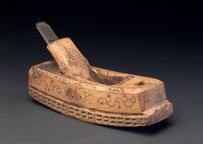

Wooden pole lathe
- Made:
- circa 1800 in Whitechapel
Wooden pole lathe used for brass finishing, in possession of Thomas Noakes and Sons Ltd for nearly a century; one mounted photograph of old pole lathe in situ
Thomas Noakes and Sons were described as 'Brass and cock founders, hydraulic engineers, coppersmiths, pump makers etc., manufacturers of all kinds of gun-metal fittings, of Whitechapel'. This lathe used a long, springy pole of willow depressed by a foot treadle to rotate the workpiece, which a string was wound around. This arrangement was used for a very long time before lathes of metal construction started to use a metal bed with a built-in treadle and crank driving a flywheel
Pole lathes came into use not later than the thirteenth century and may have been the European development of a type of lathe used in the Middle East. With this latter design the turner is seated on the ground, but in the pole lathe the centres have been raised to suit the standing posture and the hand-operated bow has been replaced by a spring beam, or pole, and treadle. The lathe bed consists of two oak beams mounted on posts and the headstocks are massive blocks of oak passing between the beams and each carrying an iron centre. One headstock is fixed; the other is movable and may be clamped in any desired position. A simple hand tool rest is provided. The driving cord is attached to the free end of the pole, passes around the mandrel or the work if a mandrel is not in use and then between the bed to the pedal below. The rotation of the work is thus alternately towards and away from the operator who cuts only when it is rotating towards him.
Details
- Category:
- Hand and Machine Tools
- Object Number:
- 1907-20
- Materials:
- wood (unidentified) and wrought iron
- type:
- lathe - machine
- credit:
- Thomas Noakes and Sons Ltd.




